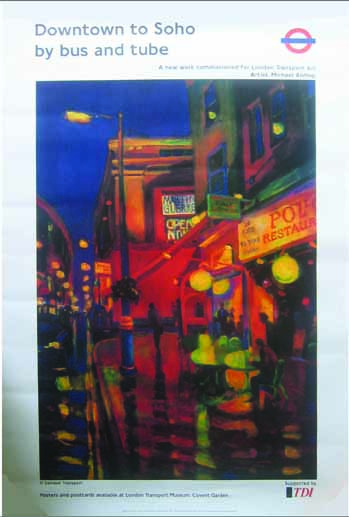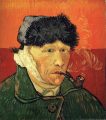This week’s ‘Spotlight’ is focused on illustrator and artist, Mike Bishop. Mike started his artistic career as a successful illustrator before journeying on to explore his personal art. Here, he offers his advice, shares his inspirations and gives us an insight into his chequered career!

How did your life as an artist begin and was it always something you wanted to do?
My Mum was quite artistic and she encouraged me to draw and paint with my two brothers at an early age..mainly eachother, literally. At school I liked art because the teacher seemed a bit more friendly and normal than the other teachers so I took ‘O’ and ‘A’-levels in art. I did a foundation course at Farnham, Surrey for a year and then in 1977 went to Brighton Polytechnic (now university) to do a BA Hons in Graphic Design, specialising in illustration. I did have two years hiatus after the first year when I left to play in a band in London. However, our failure to become overnight jazz-fusion superstars – mainly because of the punk explosion – meant that this was short-lived and I was very happy when the college let me resume my studies, going on to get a 2.1 .
You have worked as an illustrator; how was your experience of working in this field and what advice could you offer to other artists considering this path?
Illustration is a good job but it tends to be stylistically changeable and cyclical, especially in the editorial and
advertising sectors. Art directors are always looking for fresh styles and there are always new students coming through. It also depends on the economy; I had a good run in the 1980’s and managed to get a good agent in London (Folio) which was a great help. Book illustration seems a bit more stable and though generally not as well paid as advertising work, may have greater longevity. My advice would be try to have an original style but be prepared to adapt and develop as the art director calls the shots.
You have worked for some impressive clients; how do you cope with artistic deadlines? Do you find you thrive under pressure or is it sometimes stressful?

I don’t mind deadlines; they’re often easier to handle than no deadlines at all. You always seem to get the work done even if it’s just by the skin of your teeth…even if the cat has just walked over the finished painting and you have to re-do it while the courier is waiting!
What has been your favourite illustrative piece that you’ve created and why?
My favourite commission was a poster for London underground. It was a very open brief, the subject being Soho at night. I did two paintings and gave the art director the choice. Luckily he went for my favourite. It was great to travel round London for a time and see it printed larger than life.
Your other site focuses on your paintings. When did you decide to explore this side of your work and why?
I lived in New York from 1990 to 1995 and it was there that I veered more towards painting. By this time I was getting a bit jaded as an illustrator and wanted to concentrate on my own work without the restraints of a brief. Being in a new environment is artistically stimulating and I loved the vibrancy of the city. I spent a lot of time just roaming around absorbing the sights.
You use oil and acrylic on canvas; why does this medium suit you and you used others?
I used to do a lot of colour pencil illustration but it went out of style. For my paintings, I like now to use a combination of acrylic and oil. I often use acrylic as the under coat as it dries fast and then finish off with oils as they tend to have better colours.

Are your paintings based on places you have visited or are some from your imagination?
The scenes I paint are essentially real places but I like to refine and stylize them so they end up looking slightly surreal and unusual.
Any artists who inspire you to paint the way you do?
Some of the artists I admire are David Inshaw, Michael Andrews, Edward Hopper, John Singer Sargant; most of the old masters and especially the Russian Itinerants.
Do you paint from memory, from sketchbook or do you paint on site?
For the bigger, more detailed paintings I use sketches and photos which I sometimes grid up to scale on the canvas. I also enjoy painting outside directly onto board or canvas using acrylics (again, as they dry quicker) with no preliminary drawing at all. This makes a refreshing change from the more complicated pieces. Memory must come into it too, I suppose

You have some very interesting sky/cloud details in your paintings, especially the ‘Suburban Myths’ series! The colours are very vivid; does the sky hold a particular appeal to you when you paint?
Yes, the vibrant sky in these paintings acts as a counterpoint to the often dark melancholic scene below. Also there’s the hint that the clouds may not be all that they seem. In one painting I used a photo of an explosion as cloud reference and the aeroplane vapour trails add to this mystery; has a bomb just been dropped on an ostensibly peaceful English suburban scene? This adds to the slight sense of unease and, I hope, illuminates the fragile nature of a seemingly safe environment.
Do you aim to provoke a certain response or reaction from your audience with your painting or do you strive to keep ‘meaning’ ambiguous in your work?
I like ambiguity and the fact that people are free to find their own story in each picture. Everyone looks at things slightly differently and each response will be unque. One person thought that the reflection of a boat I had painted looked like a shark. It hadn’t occurred to me until they pointed it out! Once a painting is finished it takes on it’s own personality.
How important is exhibiting to you and do you feel it’s essential for an artist to ‘get out there’ as well as having a website?
I like to exhibit although it’s not essential. Working towards a show can help structure your time and gives you something tangible to work towards. You can also work on a series or theme and it can help to concentrate your thoughts. Also they can be self-educational; when I used to show at Francis Kyle Gallery, he would often have themed shows which would involve some research and travel to India or Russia, for example. Having a website is a good way of selling your work and getting it seen by a large number of people. You sometimes get intetesting emails from people all over the world.

How long does it take you to create a work from start to finish?
It depends on size, detail of finish, how complicated the subect matter is and again if there is a deadline. Oh, and laziness! A deadline will always speed things up. Generally the big detailed paintings take about a month. If I’m working outsisde I like to finish in one session of about two hours.
What has been the high point of your career as an artist/illustrator?
Getting a first commision is always a thrill for an illustrator. Mine was when I was still at college for a book about the Russian Revolution. I had to do a painting of Lenin talking to his troops from a train. I used my Dad as a model for Lenin. It ended up just looking like a my Dad with a false moustache on! Later on, going to the newsagent to buy a magazine with your illustration in was a lot of fun. As far as painting goes, for me really the high point is always anticipating and starting the next one.
What is next in the pipeline for you? Any new directions or exhibitions coming up?
At the moment I’m working on a series of horse paintings and continuing with the ‘Suburban Myth’ series. I hope to show at the newly-refurbished Highgate Contemporary Art Gallery in London next year and possibly the Florence Biennale in 2011.
I’d like to thank Mike for his time and his contribution to ‘Spotlight’. You can see more of his work at both his sites;
http://www.mikebishopillustration.com
http://www.mbishopart.com







